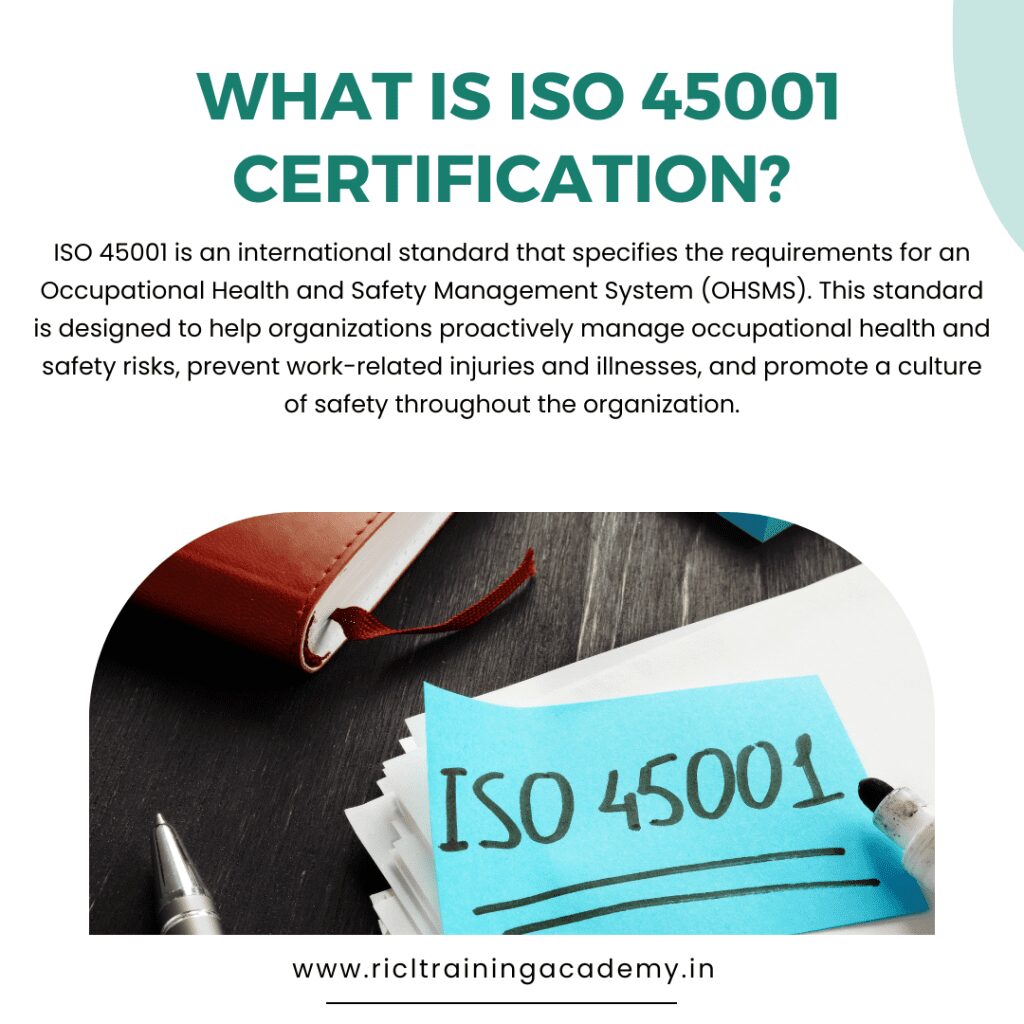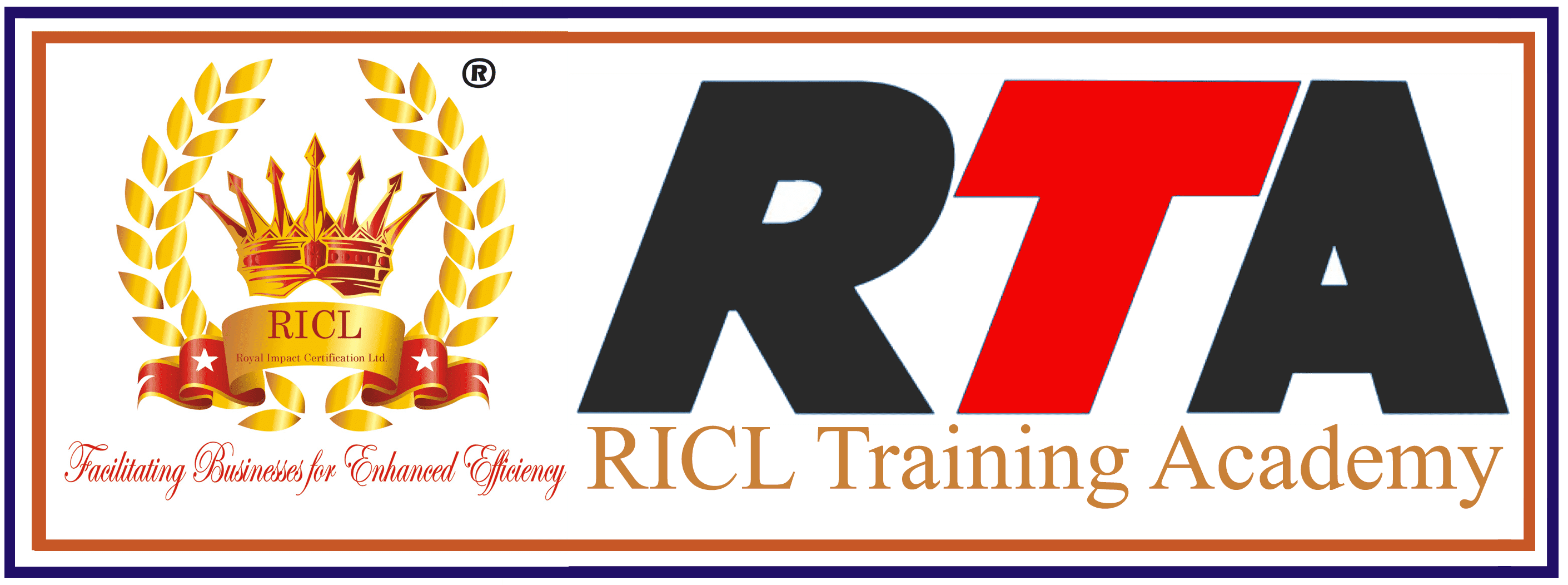
What is ISO 45001 Certification ?

ISO 45001 certification is an international standard that specifies requirements for an Occupational Health and Safety Management System (OHSMS). Published by the International Organization for Standardization (ISO), ISO 45001 provides organizations with a framework to proactively improve occupational health and safety performance, prevent work-related injuries and illnesses, and create a safe and healthy workplace environment. This essay explores the significance of ISO 45001 certification, its key components, benefits to organizations, and its role in promoting occupational health and safety.
Understanding ISO 45001 Certification
ISO 45001:2018 is the latest version of the standard and replaces the previous OHSAS 18001 standard. It is designed to be applicable to organizations of all sizes and industries, from manufacturing and construction to services and healthcare, aiming to prioritize the health, safety, and well-being of employees and stakeholders. ISO 45001 provides a systematic approach to identify hazards, assess risks, implement controls, and continually improve occupational health and safety performance within the organization.
Principles of ISO 45001:2018
ISO 45001:2018 is built upon several core principles that guide organizations in managing occupational health and safety effectively:
Leadership and Worker Participation: Top management demonstrates leadership and commitment to occupational health and safety, while workers actively participate in the development and implementation of the OHSMS.
Worker Involvement and Consultation: Organizations engage workers at all levels, ensuring their involvement in hazard identification, risk assessment, and decision-making processes related to occupational health and safety.
Risk-Based Approach: Emphasizing the identification of hazards, assessment of risks, and implementation of controls to eliminate or minimize risks to occupational health and safety.
Performance Evaluation and Monitoring: Monitoring and measuring occupational health and safety performance through data collection, analysis, and evaluation to ensure continual improvement and effectiveness of the OHSMS.
Legal Compliance: Ensuring compliance with applicable legal and regulatory requirements related to occupational health and safety, as well as industry standards and best practices.
Continual Improvement: Promoting a culture of continuous improvement through proactive measures, corrective actions, and preventive actions to enhance occupational health and safety performance.
Benefits of ISO 45001 Certification
ISO 45001 certification offers numerous benefits to organizations committed to ensuring a safe and healthy workplace environment:
Reduced Workplace Incidents and Injuries: By implementing ISO 45001, organizations can identify and mitigate occupational health and safety hazards, reducing the likelihood of workplace incidents, injuries, and illnesses among employees.
Improved Compliance and Legal Requirements: ISO 45001 helps organizations comply with occupational health and safety laws, regulations, and standards applicable to their operations. Certification demonstrates an organization’s commitment to legal compliance and regulatory requirements, minimizing legal risks and liabilities.
Enhanced Employee Morale and Productivity: A safe and healthy workplace environment fosters employee morale, satisfaction, and productivity. ISO 45001 encourages organizations to prioritize worker well-being, promote a positive safety culture, and empower employees to actively contribute to occupational health and safety initiatives.
Cost Savings and Operational Efficiency: Preventing workplace injuries and illnesses through effective hazard identification and risk management can result in cost savings related to healthcare expenses, workers’ compensation claims, and productivity losses associated with absenteeism and downtime.
Stakeholder Confidence and Reputation: ISO 45001 certification enhances an organization’s reputation as a responsible employer committed to protecting the health and safety of its workforce. Certification builds trust and confidence among stakeholders, including customers, suppliers, investors, and the community.
Competitive Advantage and Market Differentiation: ISO 45001 certification can provide a competitive edge in the marketplace by demonstrating superior occupational health and safety performance compared to competitors. Certification may be a requirement for participating in tenders, contracts, and industry-specific certifications.
Emergency Preparedness and Response: ISO 45001 promotes effective emergency preparedness and response procedures, ensuring organizations are equipped to manage and mitigate emergency situations, such as accidents, incidents, and natural disasters affecting occupational health and safety.
Process of ISO 45001 Certification
The process of achieving ISO 45001 certification typically involves the following steps:
Gap Analysis: Conducting a thorough assessment of current occupational health and safety management practices against ISO 45001 requirements to identify gaps and areas for improvement.
OHSMS Development: Developing and documenting an Occupational Health and Safety Management System that aligns with ISO 45001 requirements, including policies, objectives, procedures, and controls.
Implementation: Implementing the OHSMS throughout the organization, ensuring awareness, training, and involvement of employees at all levels to support occupational health and safety objectives and targets.
Internal Audit: Conducting internal audits to evaluate the effectiveness of the OHSMS, identify non-conformities, and implement corrective actions to address gaps and improve performance.
Management Review: Top management reviews the OHSMS periodically to assess its performance, suitability, and alignment with organizational goals, making adjustments and improvements as needed.
Certification Audit: Engaging an accredited certification body to conduct a certification audit to verify conformity of the OHSMS with ISO 45001 requirements.
Certification Decision: Upon successful completion of the certification audit, the certification body issues ISO 45001 certification, typically valid for a specified period, subject to surveillance audits to maintain certification.
Continuous Improvement and Safety Culture
ISO 45001 certification promotes a culture of continuous improvement and safety within organizations by encouraging proactive measures to enhance occupational health and safety performance. Organizations are encouraged to monitor performance indicators, set objectives for improvement, and implement initiatives to achieve occupational health and safety goals. Continuous improvement ensures the OHSMS remains effective, relevant, and responsive to changing workplace conditions, technological advancements, and regulatory requirements.
Conclusion
ISO 45001 certification is essential for organizations committed to prioritizing occupational health and safety, protecting employees, and fostering a safe and healthy workplace environment. The standard provides a systematic framework for establishing and maintaining an Occupational Health and Safety Management System that identifies hazards, assesses risks, and implements controls to prevent work-related injuries and illnesses. ISO 45001 certification demonstrates an organization’s commitment to compliance with legal requirements, continuous improvement in occupational health and safety performance, and enhancement of stakeholder confidence and reputation. By implementing ISO 45001, organizations can mitigate occupational health and safety risks, improve employee well-being, and achieve sustainable business success in a competitive global marketplace. ISO 45001 certification is a strategic investment in occupational health and safety management practices that aligns with organizational goals and values, ensuring the well-being and resilience of the workforce for the benefit of all stakeholders involved.
Lead Auditor & Internal Auditor Training: QMS, EMS, OHSMS + Awareness Courses
Refine your know-how in Quality Management Systems by taking our all-inclusive Lead Auditor QMS training course. We equip you with skills necessary for effective auditing as well as ensuring conformance with ISO standards. It is an excellent resource for people who want to become professionals in QMS auditing through detailed knowledge and practical information.”
Become a certified Lead Auditor in Environmental Management Systems with our specialized training course. This program offers necessary know-how and skills for conducting effective inspections while also promoting environmental compliance according to ISO regulations. The perfect opportunity for those looking to progress their career further into the realm of environmental management”
Pursue your career growth using our Lead Auditor OHSMS training course, which is tailored towards equipping you with the skills needed to undertake comprehensive evaluations of Occupational Health and Safety Management Systems. Obtain practical capabilities as well as experience that guarantee individual workplaces’ security conformity with the most recent ISO requirements”.
Our Internal Auditor QMS training can help you improve your auditing skills. This course covers the principles and practices necessary for conducting internal audits of Quality Management Systems. Ideal for professionals looking to increase their understanding of QMS and contribute to organizational excellence.
Our Internal Auditor EMS course will help you enhance your skills in environmental auditing. Learn techniques and standards needed to implement efficient internal audits of environmental management systems, ensuring ISO compliance and its environmental sustainability.
The purpose of our Internal Auditor OHSMS training is to equip you with the necessary skills to conduct effective internal audits. This course gives an extensive overview on how to audit Occupational Health & Safety Management Systems so that you can achieve compliance and create a safe workplace.
Hone your understanding of Quality Management Systems (QMS) through our Awareness Auditor QMS. These courses provide a basic understanding of the principles, benefits and implementation strategies of QMS making them instrumental for improving quality management practices by individuals or teams.
Familiarize yourself with essential knowledge regarding the Environmental Management Systems by exploring our Awareness Auditor EMS. The courses offer an overview of the principles of EMS which will help you comprehend environmental policies and procedures along with their importance in achieving sustainability targets.
Out training programs on Occupational Health and Safety Management Systems are meant to improve your awareness in this field. This course is intended for organizations and individuals, they provide essential information on OHSMS principles and practices that lead to safer and compliant work environments.
Other Blogs
- Adaptability Thrive in a Dynamic World
- Artistic Sense Elevate Expression & Drive Innovation
- Body Language A Key Form of Non-Verbal Communication
- Business Ethics: Upholding Integrity and Sustainability
- Business Etiquette Cultivating Professionalism and Success
- Business Trend Awareness Stay Ahead & Drive Success
- Collaboration Foster Synergy for Collective Success
- Competitiveness Driving Excellence & Superior Performance
- Conflict Resolution Navigate Tensions for Positive Results
- Crisis Management Strategic Response & Communication
- Critical Thinking Empower Strategic Decisions
- Customer Service Excellence: Fostering Relationships and Driving Success
- Customizing ISO Training for Different Industry Needs: A Tailored Approach
- Dealing with Difficult People Constructive Interaction Tips
- Decision Making: Strategies for Complex Environments
- Delegation Strategic Empowerment for Success
- Design Sense Inspire Creativity & Spark Innovation
- Diplomacy Navigate Relationships & Achieve Goals
- Disability Awareness Embracing Inclusion and Empowerment
- Dispute Resolution Foster Collaboration & Harmony
- Diversity Awareness Fostering Inclusion and Collaboration
- Empathy Enhance Understanding & Build Stronger Connections
- Entrepreneurial Thinking Cultivating Innovation and Initiative
- Facilitation Enhance Group Dynamics Effectively
- Feeling Stagnant in Your Career? Start Here
- Giving Feedback Bridging Performance Gaps Effectively
- Humor A Universal Aspect of Human Experience
- Inspiring Cultivate Authentic Leadership
- Interviewing Skills Effective Communication in Recruitment
- ISO 14001 Lead Auditor Courses PDF Download
- ISO 14001 Lead Auditor Courses Study Material
- ISO 14001: Environmental Management Training Essentials
- ISO 22301 Internal Auditor Courses Material Download
- ISO 22301 Lead Auditor Courses Fees
- ISO 22301 Lead Auditor Courses Material Download
- ISO 22301 Lead Auditor Courses PDF Download
- ISO 30000 Internal Auditor Courses Material Download
- ISO 37001 Lead Auditor Courses PDF Download
- ISO 37001 Lead Auditor Courses Study Material
- ISO 41001 Internal Auditor Courses Material Download
- ISO 41001 Lead Auditor Courses Material Download
- ISO 41001 Lead Auditor Courses PDF Download
- ISO 41001 Lead Auditor Courses Study Material
- ISO 45001 Internal Auditor Courses Material Download
- ISO 45001 Lead Auditor Courses Fees
- ISO 45001 Lead Auditor Courses Material Download
- ISO 45001 Lead Auditor Courses PDF Download
- ISO 45001 Lead Auditor Courses Study Material
- ISO 50001 Internal Auditor Courses Material Download
- ISO 50001 Lead Auditor Courses Fees
- ISO 50001 Lead Auditor Courses Material Download
- ISO 50001 Lead Auditor Courses PDF Download
- ISO 50001 Lead Auditor Courses Study Material
- ISO 50001 Energy Management Training for Sustainability
- ISO 9001 Certification A Comprehensive Training Guide
- ISO 9001 Internal Auditor Courses Material Download
- ISO 9001 Lead Auditor Certificate Course
- ISO 9001 Lead Auditor Certification in India
- ISO 9001 Lead Auditor Courses Benefits
- ISO 9001 Lead Auditor Courses Cost
- ISO 9001 Lead Auditor Courses Exam Question and Answers
- ISO 9001 Lead Auditor Courses Fees
- ISO 9001 Lead Auditor Courses Fees
- ISO 9001 Lead Auditor Courses Fees in Chennai,Noida,Delhi
- ISO 9001 Lead Auditor Courses PDF Download
- ISO 9001 Lead Auditor Courses Study Material
- ISO Certification in Delhi NCR
- ISO Certification in India
- ISO Certification in Noida
- ISO Full Form
- ISO Lead Auditor Training Near Noida
- ISO Training for New Employees: Onboarding and Integration Best Practices
- Latest ISO Training Courses & Certificates
- Lead Auditor Certification
- Lead Auditor Course
- Lead Auditor ISO 14001 Course
- Lead Auditor ISO 22000 Course
- Lead Auditor ISO 45001 Course
- Lead Auditor ISO 9001 Course
- Lead Auditor Online Courses
- Lead Auditor Salary
- Lead Auditor Training
- Lead Auditor Training Provider in Delhi
- Lead Auditor Training Provider in India
- Lead Auditor Training Provider in Noida
- Listening The Cornerstone of Effective Communication
- Adaptability Thrive in a Dynamic World
- Artistic Sense Elevate Expression & Drive Innovation
- Body Language A Key Form of Non-Verbal Communication
- Business Ethics: Upholding Integrity and Sustainability
- Business Etiquette Cultivating Professionalism and Success
- Business Trend Awareness Stay Ahead & Drive Success
- Collaboration Foster Synergy for Collective Success
- Competitiveness Driving Excellence & Superior Performance
- Conflict Resolution Navigate Tensions for Positive Results
- Crisis Management Strategic Response & Communication
- Critical Thinking Empower Strategic Decisions
- Customer Service Excellence: Fostering Relationships and Driving Success
- Customizing ISO Training for Different Industry Needs: A Tailored Approach
- Dealing with Difficult People Constructive Interaction Tips
- Decision Making: Strategies for Complex Environments
- Delegation Strategic Empowerment for Success
- Design Sense Inspire Creativity & Spark Innovation
- Diplomacy Navigate Relationships & Achieve Goals
- Disability Awareness Embracing Inclusion and Empowerment
- Dispute Resolution Foster Collaboration & Harmony
- Diversity Awareness Fostering Inclusion and Collaboration
- Empathy Enhance Understanding & Build Stronger Connections
- Entrepreneurial Thinking Cultivating Innovation and Initiative
- Facilitation Enhance Group Dynamics Effectively
- Feeling Stagnant in Your Career? Start Here
- Giving Feedback Bridging Performance Gaps Effectively
- Humor A Universal Aspect of Human Experience
- Inspiring Cultivate Authentic Leadership
- Interviewing Skills Effective Communication in Recruitment
- ISO 14001 Lead Auditor Courses PDF Download
- ISO 14001 Lead Auditor Courses Study Material
- ISO 14001: Environmental Management Training Essentials
- ISO 22301 Internal Auditor Courses Material Download
- ISO 22301 Lead Auditor Courses Fees
- ISO 22301 Lead Auditor Courses Material Download
- ISO 22301 Lead Auditor Courses PDF Download
- ISO 30000 Internal Auditor Courses Material Download
- ISO 37001 Lead Auditor Courses PDF Download
- ISO 37001 Lead Auditor Courses Study Material
- ISO 41001 Internal Auditor Courses Material Download
- ISO 41001 Lead Auditor Courses Material Download
- ISO 41001 Lead Auditor Courses PDF Download
- ISO 41001 Lead Auditor Courses Study Material
- ISO 45001 Internal Auditor Courses Material Download
- ISO 45001 Lead Auditor Courses Fees
- ISO 45001 Lead Auditor Courses Material Download
- ISO 45001 Lead Auditor Courses PDF Download
- ISO 45001 Lead Auditor Courses Study Material
- ISO 50001 Internal Auditor Courses Material Download
- ISO 50001 Lead Auditor Courses Fees
- ISO 50001 Lead Auditor Courses Material Download
- ISO 50001 Lead Auditor Courses PDF Download
- ISO 50001 Lead Auditor Courses Study Material
- ISO 50001 Energy Management Training for Sustainability
- ISO 9001 Certification A Comprehensive Training Guide
- ISO 9001 Internal Auditor Courses Material Download
- ISO 9001 Lead Auditor Certificate Course
- ISO 9001 Lead Auditor Certification in India
- ISO 9001 Lead Auditor Courses Benefits
- ISO 9001 Lead Auditor Courses Cost
- ISO 9001 Lead Auditor Courses Exam Question and Answers
- ISO 9001 Lead Auditor Courses Fees
- ISO 9001 Lead Auditor Courses Fees
- ISO 9001 Lead Auditor Courses Fees in Chennai,Noida,Delhi
- ISO 9001 Lead Auditor Courses PDF Download
- ISO 9001 Lead Auditor Courses Study Material
- ISO Certification in Delhi NCR
- ISO Certification in India
- ISO Certification in Noida
- ISO Full Form
- ISO Lead Auditor Training Near Noida
- ISO Training for New Employees: Onboarding and Integration Best Practices
- Latest ISO Training Courses & Certificates
- Lead Auditor Certification
- Lead Auditor Course
- Lead Auditor ISO 14001 Course
- Lead Auditor ISO 22000 Course
- Lead Auditor ISO 45001 Course
- Lead Auditor ISO 9001 Course
- Lead Auditor Online Courses
- Lead Auditor Salary
- Lead Auditor Training
- Lead Auditor Training Provider in Delhi
- Lead Auditor Training Provider in India
- Lead Auditor Training Provider in Noida
- Listening The Cornerstone of Effective Communication

TESTIMONIALS
What Our Cutomers are Saying About us

Ruis aute irure dolor in reprehender voluptate velit esse cillum dolore fugiat pariatur sint occaecat cupidata non proie sunt in culpa aui officede









Reach us at:
info@ricltrainingacademy.in
support@ricltrainingacademy.in
sales@ricltrainingacademy.in
complaint@ricltrainingacademy.in
Call us at:
9355650992
9355650993
Visit us at:
Royal Impact Certification Limited
623 Tower -B, The Ithum Sector – 62, Noida, 201301.
Copyright © 2024 RICL Training Academy Team

